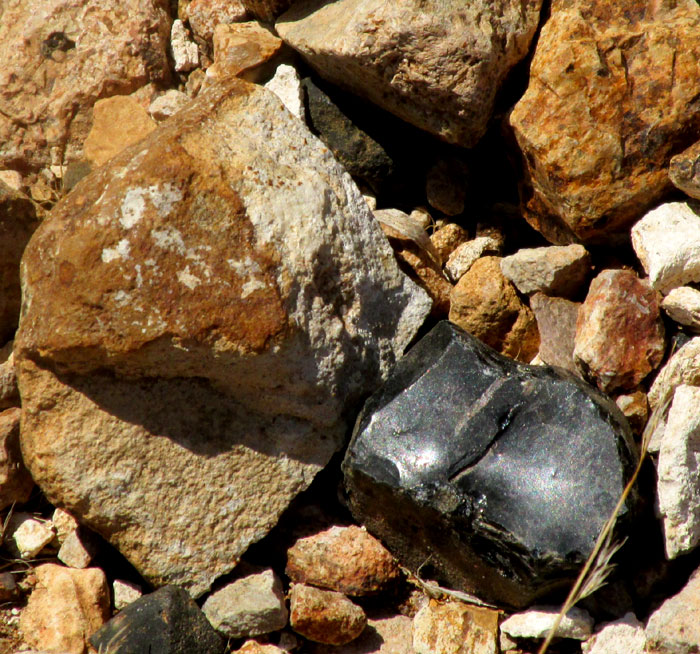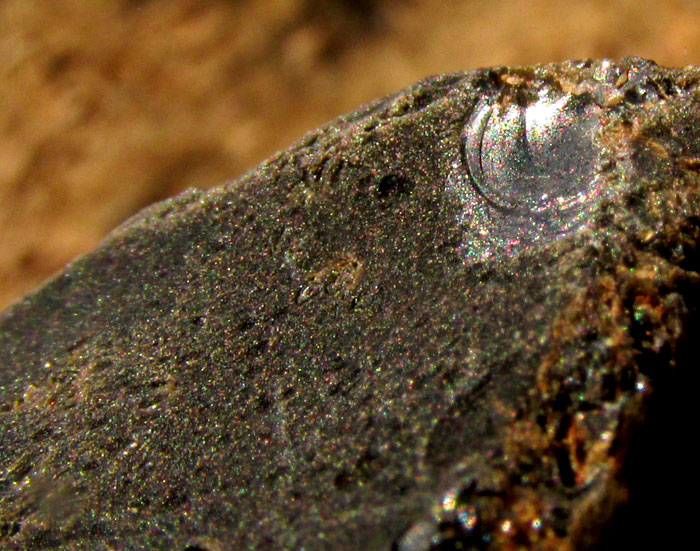Excerpts from Jim Conrad's
Naturalist Newsletter
entry dated May 20, 2022, notes from a camping trip among hills about 7kms ENE of Tequisquiapan, Querétaro state, MÉXICO
OBSIDIAN ON THE TRAIL

Following a cattle trail running along the valley floor as it slowly descended toward an isolated lake, at one point briefly I passed through an area where somewhat shiny, black rocks averaging the size of a walnut lay on the ground, as shown above. They were mixed among other kinds of rocks, which were mostly rusty-brown to white, and during my passage they appeared only briefly.
The black rocks made sense, because the surrounding hills were composed mostly of rhyolite, a light-colored volcanic rock formed when high-silica lava (silica being SiO2) cools so slowly that visible crystals of various minerals, especially quartz, form as the cooling rock solidifies. When high-silica lava cools so fast that visible crystals don't have the time to form -- as at its air-exposed surface and when it flows into water -- it forms the black rock in the picture.
The black rock is composed of OBSIDIAN, and like the rhyolite in the surrounding hills, this obsidian is mostly silica. Most obsidian rock is 70% or more silica (also called silicon dioxide), with the other minerals in the rock typically being mostly aluminum, sodium and potassium. These melted minerals, including the silica, have a high viscosity when they flow -- they're "watery." Most but not all obsidian is formed in the upper part of rhyolitic lava flows, because that's the part of the flow that cools fastest.
Obsidian is basically natural black glass. If it contains crystals, they're too small to see without high magnification. Regular, modern window glass is about 74% silica, about the same as with most obsidian. In the molten soups from which window glass and obsidian emerge, it's the mix of minerals other than silica which provides varying features such as color, hardness, and breakability.
Most of the obsidian rocks on the cow trail weren't as shiny as the above rock. That rock had broken from a bigger hunk fairly recently (recently in the geological time scale), so its surface was still a bit shiny. However, even it was already somewhat dull, plus its sharp edges, once you looked closely, really weren't as sharp as freshly broken glass. That's because the obsidian rock in the picture is slowly disintegrating. Near the above rock lay another blackish rock that was even duller and with more rounded edges, part of which is shown below:

Over the years as erosional processes moved this rock downslope onto the cow trail, its sharp edges were chipped away and water was absorbed into its surface region. Water molecules disrupted the obsidian's particular molecular configuration so that the surface of the rock became less glass-like -- duller and less sharply angled. That special kind of weathering process is so important in geology that it has the special name of devitrification -- "de-glassing."
In the above picture, at the rock's top, right corner, relatively recently (geologically) something has hit the rock, knocking a chip from it, leaving a shallow pit with a round margin. In geology, that kind of fracturing also has a special name. It's a conchoidal fracture, defined as a breakage that is smooth, curved, typically slightly concave, with the fracture not following any natural planes of separation. If you shatter a rock composed of crystalline calcite, breakage will follow "planes of separation" produced by crystal faces. But obsidian doesn't have crystals of any meaningful size, so you get conchoidal fracture. Usually conchoidal fractures exhibit concentric undulations suggestive of the growth patterns on a seashell, thus the name: the "conch" in "conchoidal" is derived from the Latin word concha, meaning shellfish, such as the conch shells found on some beaches.
Obsidian rocks have been important in human history, because freshly fractured obsidian has very sharp edges, like any normal shattered glass. Our ancient ancestors broke up hunks of high-silica rocks such as flints, chert, and -- when they were available -- obsidian, chose properly sized and shaped pieces of the shattered rock, and chipped out, or "knapped," projectile points from them. Black obsidian points were especially valued and often used ceremonially. Obsidian points have been found in archaeological sites great distances from any naturally occurring obsidian sources. Wikipedia has a page section on Prehistoric and Historical uses of obsidian.
As I descended the valley, which presumably at one point cut through the stratum of obsidian from which my trail rocks had descended, I looked for obsidian outcroppings, but saw none. That's not surprising, though, knowing that obsidian weathers so relatively easily. If I'd been looking for a layer of granite, there might have been a cliff of it.
That day, as I backpacked amid daunting heat and sizzling sunlight, I was just glad to have little black rocks on the cattle trail occupy my mind with thoughts of geological, chemical and archaeological processes.